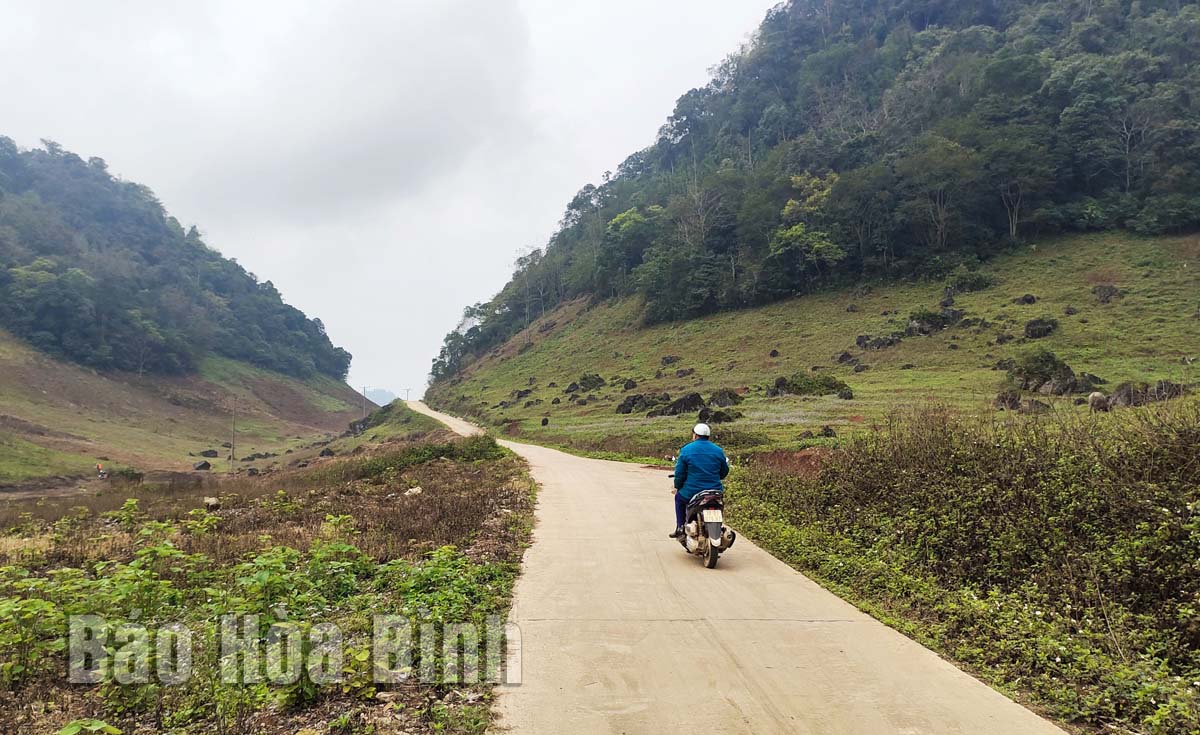
(HBO) - In recent years, Da Bac district of Hoa Binh province has focused on developing transport infrastructure in rural areas, considering it an important solution to speed up the hunger eradication and poverty alleviation process and the new-style rural area building in the locality.
A rural road in Trung Tam hamlet, Trung Thanh commune. Da Bac district has invested in developing rural transport infrastructure in recent years.
The transportation infrastructure development in the district faces many difficulties because Da Bac is an upland district with hilly and mountainous terrains. In addition, the district is considered a hot spot for natural disasters, especially landslides during the rainy season which damage the local transportation system.
At present, Da Bac has a total of 1,317 km of roads, including 163.5 km of district roads, 128.7 km of communal roads, 453.62 km of hamlet and village roads, over 305 km of alleys, nearly 232 km of roads in production areas and field roads, and over 34 km of urban roads. However, there are still more than 254 km of roads with uneven surface.
The district has also 34 bridges and 32 spillways, with a total length of 627.5m, and 799m, respectively.
According to Dao Tien Quyet, Head of the economic – infrastructure division of Da Bac district, the technical conditions, structure, scale and ability of roads, bridges and spillways in the district basically meet the travel and goods transport demand of local residents.
However, due to the influence of rains and floods, some roads, bridges and tunnels in the locality have been damaged and degraded. The construction of a number of transport projects remains slow, significantly affecting the travel of people and vehicles.
To address these difficulties, the local authority has mobilised over 1 trillion VND (over 42.64 million USD) to invest in developing transport infrastructure. Since 2021, the district has focused on implementing a project to concrete rural transport roads in the 2021-2025 period.
Accordingly, the total budget for the project is over 2.25 trillion VND. As scheduled, 5 km of 12 transportation roads in the district are concreted.
So far, 4.2 km of rural roads in Dong Chum, Dong Ruong, Tan Minh, Giap Dat, Tien Phong, and Yen Hoa communes have been completed.
The district's authority has also accelerated the implementation of new-style rural area building movement. A total of nearly 408 billion VND was allocated to the locality to implement the criteria No. 2 on rural transport infrastructure development.
Accordingly, inter-village roads and over 40 km of hamlet roads in Tan Minh commune have been concreted. The district has also concentrated on preventing and overcoming consequences of natural disasters along roads, especially at weak bridges and spillways./.
The Standing Board of the Hoa Binh provincial Party Committee has agreed in principle on a proposal by the Standing Board of the Party Committee of Hoa Binh city to gather feedback on the city’s 1:2000 zoning plan, which forms part of its broader urban development strategy.
Hoa Binh province has made notable progress in public administration reform and digital government development, with the satisfaction index among citizens and businesses reaching over 84%, according to recent government evaluations.
Thanks to great efforts by local authorities in recent times, the governance and public administration performance of Mai Chau district has been significantly improved.
In the afternoon of June 6, the Party Committee, the People's Council, the People's Committee and the Fatherland Front of Lac Son district solemnly held a meeting to celebrate the 139th anniversary of the district's founding (1886–2025) and the 79th anniversary of the establishment of the district's Party Committee (1946–2025). There was the attendance of Mr. Bui Van Thang, the Vice Chairman of the Provincial People's Council; Mr. Quach Tat Liem, the Vice Chairman of the Provincial People's Committee; Ms. Dang Bich Ngoc, the Deputy Head of the National Assembly Delegation of the province; as well as the former leaders of the province and district through various periods, who are the natives of the district.
Implementing the Politburo’s Resolution No. 57-NQ/TW on breakthroughs in science – technology, innovation, and digital transformation is a golden opportunity for the northern mountainous province of Hoa Binh to renew growth model, improve competitive edge and shorten digital gap.
Resolution 57-NQ/TW, issued by the Politburo on December 22, 2024, identifies sci-tech, innovation, and digital transformation as strategic breakthroughs to build a developed and prosperous nation. In Hoa Binh province, this spirit is not just a slogan, it’s being put into action through concrete initiatives that form a "new development triangle”: digital citizenship, digital economy, and digital administration.



